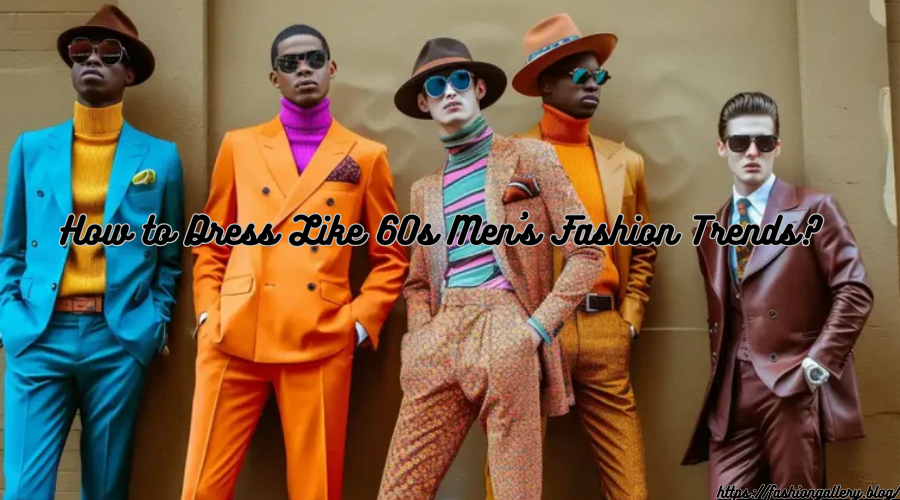Men’s fashion saw significant change during the 1960s, especially. The emergence of youth culture during this decade resulted in the radical transformation of conventional trends into fresh looks. A distinctive look that emphasized individualism was developed by the societal upheaval influenced by art, music, and politics. Men’s design choices, from fitted suits to laid-back clothes, mirrored bigger cultural upheavals, such as the countercultural uprisings and the civil rights struggle. The 60s Fashion Men are remembered as the history of fashion because of the creative and free attitude that permeated the evolving patterns. This introduction lays the groundwork for a more thorough examination of the different influences. Styles that evolved during this legendary decade.
Who Introduced Fashion in the 60s?
From sharply fitted suits to quirky, colorful clothing that reflected the social upheavals of the era, The Beatles became major fashion. Male fashion was revolutionized in the 60s Fashion Men by a diverse group of individuals who helped to create the classic looks of the time. The bounds of traditional menswear were stretched by designers such as Pierre Cardin and Rudi Gernreich. They introduced aspects like whimsical patterns and loose suits along with avant-garde designs and unorthodox forms. Men’s clothes from the 60s featured a striking mix of sharp tailored suits, vibrant patterns and relaxed styles.. Yves Saint Laurent’s inventive approach to gender fluidity had an impact on men’s styles despite his fame being predominantly associated with women’s fashion.
Models of Style in 60s
Although a number of fashion legends came of age in the 1960s, the decade also saw opposition to the quickly evolving fashion trends. There was a sense of perplexity regarding identity and masculinity as a result of many traditionalists viewing the daring fashion choices of icons in 60s Fashion Men. Such as Yves Saint Laurent and Giorgio Armani as a break from traditional menswear. Rather than establishing trends, celebrities occasionally came under fire for their quirky style choices, which some viewers found foolish or unduly flashy. A division between modern and classic styles resulted from the emphasis on individualism frequently overshadowing the traditional elegance that many still prized. Fashion magazines occasionally turned off readers who liked traditional attire, rather than always supporting these new styles. 60s Fashion Menswear was characterized by a daring blend of sleek tailoring and reflecting the decade’s cultural revolution.

Legacy of 60s Casual Fashion
As the decade went on, males started wearing casual clothing more frequently, which reflected a movement in society toward ease and comfort. A break from strict clothing norms was signaled by the arrival of products like denim, loose pants, and polo shirts in 60s Fashion Men. This section will go over how men’s desire for greater fashion freedom coincided with the emergence of informal trends and shifts in societal attitudes. As denim became a wardrobe need for every man, companies like Levi’s gained notoriety. In 60s Fashion Menswear ,men were able to show their individuality through their attire thanks to the creative combinations created by the blending of formal and casual components. Another factor influencing this change in fashion was the emerging young culture, which prioritized individuality above conformity.
Iconic Styles that Define the Decade
A significant change in styles and cultural influences marked the men’s fashion of the 1960s, which was colorful and lively. Icons such as The Beatles personified this look, transitioning towards more colorful and diverse ensembles from traditional suits as the decade went on. Also, casual clothing became more popular, with youth-oriented mainstays like graphic T-shirts, denim jackets, and baggy fits. Rock ‘n’ roll had a major influence on fashion in 60s Fashion Men which gave rise to stylish items like leather jackets that radiated a rebellious vibe. New cuts and materials that combined classic tailoring with modern aesthetics were introduced by designers like Pierre Cardin and Yves Saint Laurent, who significantly contributed to the redefining of menswear. A further indication of shifting views on fashion in work environments was the advent of casual Friday and more laid-back office wear.. Overall, Mens Clothes From the 60s fashion trends set the foundation for later trends in fashion by reflecting the social and cultural transformations of the age rather than merely being about clothes.
Impact of Celebrity Culture on Fashion In 60s
In the 1960s fashion was greatly impacted by celebrity culture which shaped trends in unprecedented ways. Celebrities were more than just distant figures as pop culture and television gained prominence. Instead, they served as personable role models who inspired young people to emulate their looks. The ready to wear apparel during this period made high fashion more widely available. The 60s Fashion Men was marked by bold experimentation with styles ranging from tailored suits and slim-fit trousers . They reflect a culture of self-expression and rebellion. As celebrities adopted and promoted a range of styles from boho to mod. They contributed to the democratization of fashion by promoting individualism and experimentation among the general public in 60s Fashion Menswear . Modern marketing methods were made possible by the blending of fashion and fame where star power played a crucial role in shaping consumer trends.
Conclusion
Men’s fashion from the 1960s has a significant and enduring legacy. This decade’s trends and societal upheavals shaped modern fashion and men’s ways of expressing themselves through clothes. The acceptance of individualism, the shift from formal to informal clothing, and the fusion of music and art with fashion are all characteristics of this era. This final segment will consider how both modern designers and fashion aficionados are still influenced by the 60s Fashion Men. When we reflect on this vibrant decade, it is evident that the innovations and mindsets developed in the Men’s Clothes from the 60s have influenced men’s fashion for decades to come. The enduring influence of this period, which acts as a continual reminder of how clothing can convey cultural movements and identity, cannot be overlooked in fashion history.

